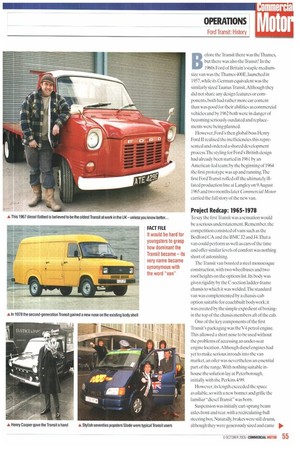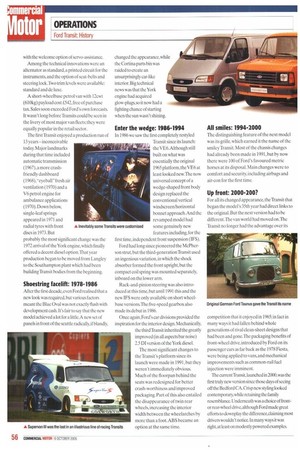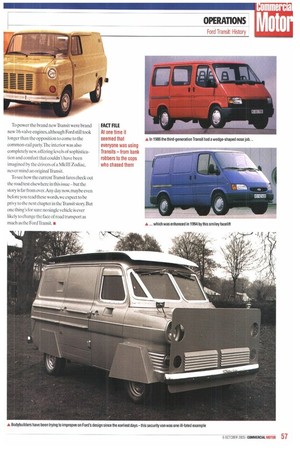STORY 1+1 TRANSIT
Page 54

Page 55

Page 56

Page 57

If you've noticed an error in this article please click here to report it so we can fix it.
The Ford Transit has changed the face of road transport more than any other single
vehicle. Cohn Barnett examines its history. Before the Transit there was the Thames, but there was also the Transit! In the 1960s Ford of Britain's staple mediumsize van was the Thames 400E, launched in 1957, while its German equivalent was the similarly sized Taunus Transit.Although they did not share any design features or components, both had rather more car content than was good for their abilities as commercial vehicles and by 1962 both were in danger of becoming seriously outdated and replacements were being planned.
However, Ford's then global boss Henry Ford II realised the inefficiencies this represented and ordered a shared development process. The styling for Ford's British design had already been started in 1961 by an American-led team; by the beginning of 1964 the first prototype was up and running.The first Ford Transit rolled off the ultimately illfated production line at Langley on 9 August 1965 and two months later commercial Motor carried the full story of the new van.
Project Redcap: 1965-1978 To say the first Transit was a sensation would be a serious understatement. Remember, the competition consisted of vans such as the Bedford CA and the BMC J2 and .14.That a van could perform as well as cars of the time and offer similar levels of comfort was nothing short of astonishing.
TheTransit van boasted a steel monocoque construction, with two wheelbases and two roof heights on the options list. Its body was given rigidity by the C-section ladder-frame chassis to which it was welded.The standard van was complemented by a chassis-cab option suitable for coachbuilt bodywork; it was created by the simple expedient of boxingin the top of the chassis members aft of the cab.
One of the key components of the first Transit's packaging was the V4 petrol engine. This allowed a short nose to be used without the problems of accessing an under-seat engine location. Although diesel engines had yet to make serious inroads into the van market, an oiler was nevertheless an essential part of the range. With nothing suitable inhouse the solution lay at Peterborough, initially with the Perkins 4/99.
However, its length exceeded the space available, so with a new bonnet and grille the familiar "diesel Transit" was born.
Suspension was initially cart-sprung beam axles front and rear, with a recirculating-ball steering box. Naturally, brakes were still drums, although they were generously sized and came with the welcome option of servo-assistance.
Among the technical innovations were an alternator as standard, a printed circuit for the instruments, and the option of seat-belts and steering lock.Two trim levels were available: standard and de luxe.
A short-wheelbase petrol van with 12cwt (610kg) payload cost £542, free of purchase tax. Sales soon exceeded Ford's own forecasts. It wasn't long before Transits could be seen in the livery of most major van fleets: they were equally popular in the retail sector.
The first Transit enjoyed a production run of 13 years—inconceivable today. Major landmarks during that time included automatic transmission (1967), a more crashfriendly dashboard (1968),"eyeball" fresh air ventilation (1970) and a V6 petrol engine for ambulance applications (1970). Down below, single-leaf springs appeared in 1971 and radial tyres with front discs in 1973. But probably the most significant change was the 1972 arrival of the York engine, which finally offered a decent diesel option.That year production began to he moved from Langley to the Southampton plant which had been building Transit bodies from the beginning.
Shoestring facelift: 1978-1986
After the first decadc,even Ford realised that a new look was required, but various factors meant the Blue Oval was not exactly flush with development cash. It's fair to say that the new model achieved a lot for a little.A new set of panels in front of the scuttle radically, if blandly, changed the appearance, while the Cortina parts bin was raided to create an unsurprisingly car-like interior. Big technical news was that the York engine had acquired glow-plugs, so it now had a fighting chance of starting when the sun wasn't shining.
Enter the wedge: 1986-1994
In 1986 we saw the first completely restyled Transit since its launch: the VE6.Although still built on what was essentially the original 1965 platform, the VE6 at least looked new.The now universal concept of a wedge-shaped front body design replaced the conventional vertical windscreen/horizontal bonnet approach. And the revamped model had some genuinely new features including, for the first time, independent front suspension (IFS).
Ford had long since pioneered the McPherson strut, but the third-generation Transit used an ingenious variation, in which the shock absorber formed the front upright, but the compact coil spring was mounted separately, inboard on the lower arm.
Rack-and-pinion steering was also introduced at this time, but until 1991 this and the new IFS were only available on short wheelbase version&The five-speed gearbox also made its debut in 1986.
Once again, Ford's car divisions provided the inspiration for the interior design. Mechanically, the thirdTransit inherited the greatly improved (in all aspects bar noise) 2.5 DI version of the York diesel.
The most significant changes to the Transit's platform since its launch were made in 1991, but they weren't immediately obvious. Much of the floorpan behind the seats was redesigned for better crash-worthiness and improved packaging. Part of this also entailed the disappearance of twin rear wheels, increasing the interior width between the wheeiarches by more than a foot.ABS became an option at the same time.
All smiles: 1994-2000
The distinguishing feature of the next model was its grille, which earned it the name of the smiley Transit. Most of the chassis changes had already been made in 1991, but by now there were 100 of Ford's favoured metric horses at its disposal. Main changes were to comfort and security, including airbags and air-con for the first time.
Up front: 2000-200?
For all its changed appearance, the Transit that began the model's 35th year had direct links to the original But the next version had to be different.The van world had moved on.The Transit no longer had the advantage over its competition that it enjoyed in 1965; in fact in many ways it had fallen behind whole generations of rival clean-sheet designs that had been and gone.The packaging benefits of front-wheel drive, introduced by Ford on its passenger cars as far back as the 1978 Fiesta, were being applied to vans, and mechanical improvements such as common-rail fuel injection were imminent.
The current Transit, launched in 2000, was the first truly new version since those days of seeing off the Bedford CA.Crisp new styling looked contemporary, while retaining the family resemblance. Underneath was a choice of frontor rear-wheel drive,although Ford made great efforts to downplay the difference, claiming most drivers wouldn't notice. in many ways it was right,at least on modestly powered examples To power the brand new Transit were brand new 16-valve engines, although Ford still took longer than the opposition to come to the common-rail party.The interior was also completely new, offering levels of sophistication and comfort that couldn't have been imagined by the drivers of a Mk III Zodiac, never mind an originalTransit.
To see how the current Transit fares check out the road test elsewhere in this issue — but the story is far from over. Any day now, maybe even before you read these words, we expect to be privy to the next chapter in the Transit story. But one thing's for sure: no single vehicle is ever likely to change the face of road transport as much as the Ford Transit. •










































































































































































































